Oms11 remote communications – Comtech EF Data OMS11 User Manual
Page 64

OMS11 1:1 Redundancy Switch
Appendix B
TM133 – Rev. 1.1
B-
1
OMS11 Remote Communications
B
B.0
Host Computer Remote Communications
Control and status messages are conveyed between the OMS11 and the host computer using
packetized message blocks in accordance with a proprietary communications specification. This
communication is handled by the Radyne Link Level Protocol (RLLP), which serves as a protocol
‘wrapper’ for the RM&C data.
Complete information on monitor and control software is contained in the Radyne RLLP
Protocol Reference Guide.
For RS485 Remote communication, install CA/3733 gender changer into
the remote port. Gender changes port from RS232 to RS485
B.0.1 Protocol Structure
The Communications Specification (COMMSPEC) defines the interaction of computer resident
Monitor and Control software used in satellite earth station equipment such as Modems,
redundancy switches, multiplexers, and other ancillary support gear. Communication is bi-
directional, and is normally established on one or more full-duplex 9600-baud multi-drop control
buses that conform to EIA Standard RS-485.
Each piece of earth station equipment on a control bus has a unique physical address, which is
assigned during station setup/configuration or prior to shipment. Valid decimal addresses on one
control bus range from 032 through 255 for a total of up to 224 devices per bus. Address 255 of
each control bus is usually reserved for the M&C computer.
B.0.2 Protocol Wrapper
The Radyne COMMSPEC is byte-oriented, with the Least Significant Bit (LSB) issued first. Each
data byte is conveyed as mark/space information with two marks comprising the stop data. When
the last byte of data is transmitted, a hold comprises one steady mark (the last stop bit). To begin
or resume data transfer, a space (00h) substitutes this mark. This handling scheme is controlled
by the hardware and is transparent to the user. A pictorial representation of the data and its
surrounding overhead may be shown as follows:
S1
S2 B
0
B
1
B
2
B
3
B
4
B
5
B
6
B
7
S1 S2, etc.
